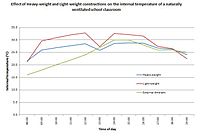
Photo from wikipedia
Abstract Simultaneous measurements of the total electron content (TEC) and the peak electron density NmF2 at vertical sounding stations enable the estimation of the equivalent slab thickness of the ionosphere.… Click to show full abstract
Abstract Simultaneous measurements of the total electron content (TEC) and the peak electron density NmF2 at vertical sounding stations enable the estimation of the equivalent slab thickness of the ionosphere. This shape parameter, defined as the ratio of the observables TEC and NmF2 of the vertical electron density profile, is closely related to the neutral gas scale height under steady-state conditions at daytime. In this paper we present for the first time a long term trend (LTT) analysis of the equivalent slab thickness for estimating long term trends of thermospheric temperature changes. The analysis is made for 5 vertical sounding stations located in the latitude range 40–70°N in Europe and covers the entire solar cycle 23 during the years 1995–2009. The observations indicate a long term decrease of the equivalent slab thickness at all ionosonde stations considered here from 11 to 62 km/decade with increasing tendency towards higher latitudes. Since the seasonal dynamics of the slab thickness clearly overestimates expected temperature changes, it has been found that composition changes, in particular the atomic oxygen/molecular nitrogen density ratio, contribute essentially to the high dynamics of the equivalent slab thickness closely associated with the occurrence of the well-known daytime winter anomaly in Northern mid-latitudes. In analogy, to explain remaining temperature overestimates in the long term trends of the equivalent slab thickness, it is assumed that a long term increase of the atomic oxygen/molecular nitrogen density ratio exist. So the contraction (decrease of scale height and equivalent slab thickness) and the lowering (decrease of the peak density height hmF2) of the electron density profile can be understood in a consistent manner. It is demonstrated that a permanent monitoring of the equivalent slab thickness can contribute to explore long term changes of the thermosphere. To get quantitative estimates of thermospheric temperature changes based on this new LTT monitoring technique, more detailed studies including first principles models are needed.
Journal Title: Journal of Atmospheric and Solar-Terrestrial Physics
Year Published: 2017
Link to full text (if available)
Share on Social Media: Sign Up to like & get
recommendations!